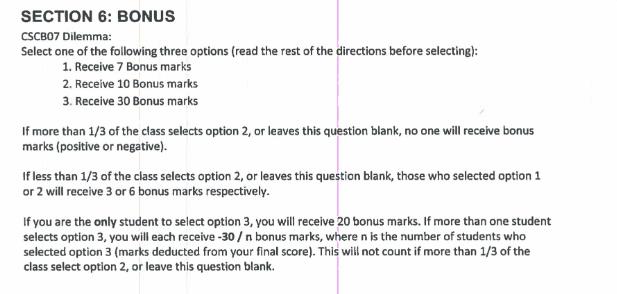When we discussed Prisoner’s Dilemma in the lecture, it reminds me of a midterm test that I took for CSCB07 a few years ago.
On the midterm test, there was a bonus question asking students to select from 3 options: 1) receive 7 bonus marks, 2) receive 10 bonus marks, and 3) receive 30 bonus marks. The rule is as follows, if more than 1/3 of students selects option 2 or leave it blank, no one will receive bonus marks; if less than 1/3 of students selects option 2 or leave it blank, students will get bonus marks according to their choice; if only 1 student select option 3, he will receive 20 bonus marks, if more than 1 student select option 3, let’s say n students choose option 3, those students will each receive -30/n bonus marks.

Option 3 seems to reward most bonus marks, but it is also the most risky option. If at least 2 students choose option 3, they will receive negative bonus marks. No one would like to take risk of getting negative bonus marks for choosing option 3, so most of students choose among option 1 and 2.
The best option is to let all students choose option 1, then everyone can receive 3 bonus marks. However, people tend to play the game in their own self-interests to maximize their payoffs. Some students would believe that everyone would choose option 1, if he picks option 2, he will get more bonus marks. Selecting option 2 is a rational choice since it maximizes individual’s payoff. People believe that the impact of their choice to the overall result is very small. However, if everyone thinks this way and play rationally to maximize their bonus marks, this will lead to having more than 1/3 of students choosing option 2, then nobody receives bonus marks.
Sadly, in the end, no one received bonus marks since there are more than 1/3 of students select option 2 or leave it blank. But it is interesting to mention that we were only one person away from having everyone to receive bonus marks. In other words, if one more person selects option 1 or 3, then everyone can receive bonus marks.
This real-life example simulates Prisoners Dilemma because individuals tend to act in their best interests but cannot end up with optimal outcome. Although we all know which option to choose will benefit everyone, it requires everyone to cooperate.
Reference
https://theconversation.com/how-understanding-the-prisoners-dilemma-can-help-bridge-liberal-and-conservative-differences-46166
One reply on “Prisoner’s Dilemma and Bonus Marks on Midterm Test”
I hope this shows up on our final exam